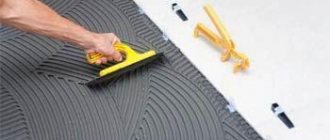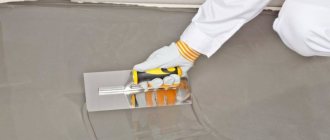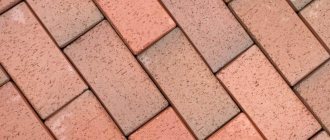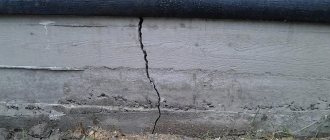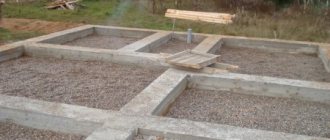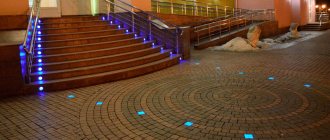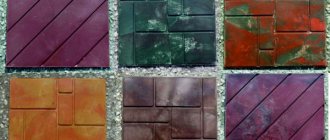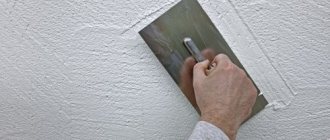In the life of a busy person, it often happens that there is a limited amount of time to decorate a living space. The quality of the work performed is directly dependent on whether all technological features were observed when laying the material and whether the required time periods were maintained, which are necessary for the mixtures and compositions to dry completely. If you decide to install the floor covering, then you need to familiarize yourself with the information about how long it will take for the tile finishing material to dry completely, after what period of time the tiles are allowed to be subjected to mechanical loads (installation of furniture, plumbing) and when it is possible to start the heated floor.
How long does it take for floor tiles to dry after installation?
What determines the drying time of the adhesive base?
The time period for drying the glue component can be found on the label; the manufacturer indicates all the necessary information there. This time period is considered approximate, because the adhesive base can dry under a wide variety of conditions, which is why you do not need to rely 100% on the information on the packaging.
The ideal conditions for complete drying of the glue are a temperature of 20...22 °C and air humidity of 60% - then the adhesive components will be able to fully adhere to the floor covering within the time indicated on the label. It is by no means always possible to fulfill such requirements in the room being repaired - for this reason, you may have to wait longer for the glue to dry.
Manufacturers correctly indicate the drying time on the glue packaging.
Important note! Complete drying of the tile material located on the floor will provide the necessary strength and reliability characteristics, because the operation of the floor covering involves exposure to heavy household items, heating, etc.
There are 3 main criteria that influence the drying of the adhesive composition intended for tile installation.
- The drying time is initially influenced by the temperature in the room and outside. If it’s warm outside, the adhesive base will dry quickly enough. You should not artificially increase the temperature in the room using heating equipment. In winter, it will take more time to dry the adhesive base compared to summer. Based on this information, the average drying period for the adhesive composition for tiles in warm weather will be 24-36 hours, and in cold weather – 36-48 hours.
- When laying out tile material, you need to take into account the temperature of the floor itself, because it tends to differ from the temperature in the room. A floor temperature of +20 °C is considered suitable. Other options are possible, but usually not less than +5°C. So, the lower the temperature of the base, the more time it takes to completely dry the adhesive base for the boards.
The lower the floor temperature, the longer the glue will take to dry. - Air humidity plays a big role in the issue of glue drying. The higher its mark, the longer the drying process will take. For this reason, you need to take into account the household purpose of the room; in the kitchen, drying the adhesive base may take 12 hours less than in the bathroom.
Test methods: how long does it take for floor tiles to dry after installation?
There is no way to determine if the floor surface is dry. You can only try to detach one tile. If the tile moves, then the required drying time has not yet passed. In this case, you shouldn’t walk, otherwise you may not give the tile a chance to stick at all.
But you can identify the tiles that are not stuck to the floor at all or which have come off. To do this, you need to knock on the tile a little. A duller sound indicates voids.
Article on the topic: How to glue linoleum to the floor: what is needed for concrete, what video to glue, what the spatula is covered with, fiberboard and PVA
Try to allow more drying time than indicated in the table on the mixture packaging
What to do with loose tiles:
- With maximum care, separate it from the base;
- Clean off any remaining adhesive;
- Using new glue, reattach the tile.
In this case, you must follow the instructions exactly and do not walk on the tiles ahead of time. Even if you are absolutely sure that the floor is dry, it is better to wait another half a day. After this, you can begin further work with the flooring, jointing the seams.
How to determine that the adhesive base has dried?
There are two methods for checking the drying of the adhesive base under the tile covering - workers with extensive experience recommend using both.
This method helps to identify those parts of the tile covering that are glued unevenly or have come off completely. It is necessary to tap each tile with a little force. In areas where there is a lack of adhesive, a muffled sound will be heard.
How to fix the defect?
- Carefully pry up the tile and remove it from the floor surface.
- Remove any remaining adhesive from the back of the tile covering.
- Re-glue the tiles using freshly diluted adhesive.
If somewhere there is not enough glue and the tile is not fixed, you need to add fresh compound, carefully lifting it
You can also try to move the tile, for which you first pry up one of the corners. It is preferable to carry out such actions in the corner part of the room, because if the tile comes off, it will be easier to re-glue it there than in the central part of the room.
You can determine whether the tile is dry by knocking on it and trying to lift it
Displacement of the tile covering indicates that the glue has not dried sufficiently: such a floor cannot be loaded. If you ignore this instruction, the tiles will stick very poorly.
Why is the drying condition of the adhesive composition important?
Information is often provided that it is permissible to use floor tiles even before the adhesive component has completely hardened. Sometimes even at this stage the seams are rubbed. This method is practiced by craftsmen with little experience.
There is no need to rush: it is better to wait until the adhesive base is completely dry - then you will not have to worry that the tile covering will shift due to premature exposure to heavy weight. There is a possibility of deformation of the tile covering in the corners of the room, where there is usually less adhesive base. As a result, the flooring will have to be laid again due to the unaesthetic appearance of the seams between the tiles.
Do not walk on uncured tiles, place furniture on them, or rub joints
Important! Even if you are sure that the floor covering has dried completely, it is better to wait an additional 12 hours to be on the safe side. After this time, you can begin grouting the joints. Take your time so you don't have to redo work that's already been done.
Factors affecting the rate of hardening
Hardening of any adhesive mixture occurs in several stages. At the first stage, it retains its adhesive properties and optimal ductility for adjustments. Primary hardening occurs when the tile is already laid on the surface, but in the first minutes it is still possible to adjust the position of the tile.
The duration of all these stages can vary depending on five basic factors:
- environmental humidity;
- ambient temperature;
- working layer thickness;
- surface type;
- brand of glue.
Ambient humidity
High air humidity increases the drying time. And, conversely, when the air is dry, floor tiles dry faster. Thus, if the manufacturer indicates on the packaging the hardening time of its glue of 1-2 days, then when used in the bathroom and other rooms with increased dampness, the time can increase to 3-4 days.
Temperature
The adhesive sets faster in rooms with elevated air temperatures.
The optimal temperature range is +20…+22 °C. Depending on the brand of tile adhesive, the value may vary between +5...+30 °C. When the air cools below +5 °C, laying tiles is not recommended. It is better to wait for the temperature to rise or use additional heating.
Unnatural heating of the room is used as a last resort, since the quality of the coating suffers, the tiles become deformed or crack.
In summer, tiles stick faster than in winter, since the composition can not only harden, but freeze. This applies to non-frost-resistant mixtures.
Layer thickness
The hardening time of tile adhesive is directly proportional to the thickness of the adhesive layer. The larger it is, the longer it will take for the tile to set. If the mixture is applied unevenly, its drying time will differ in different areas of the surface.
To reduce the thickness of the layer, you can first level the base or apply the composition with a spatula with a smaller tooth height.
Material size
The number of tile joints affects the rate of moisture evaporation from the solution. When laying small tiles or mosaics, the total area of the seams is larger than when working with large tiles, so the glue will dry much faster in the first case.
The drying speed is also affected by the density of the facing material; for example, clay floor tiles will dry faster than porcelain stoneware.
Main surface material
On a surface with a high level of moisture absorption, the adhesive solution will dry much faster. The degree of absorption is determined by the porosity of the material. The more porous it is, the better the base absorbs liquid. In this case, the glue sets faster.
On a concrete screed, the glue takes longer to dry than when gluing tiles to a standard screed, since concrete does not absorb liquid from the solution well.
Brand and type of composition
- Standard adhesives. They freeze throughout the day. When t °C drops below +5 °C, the solution can dry out for at least 3 days.
- Reinforced. Dries faster. On average, complete contraction takes 12-24 hours. They are used for installation of large-sized cladding. Adheres well to concrete.
- Superglues. Their use speeds up repair work; after gluing the tiles, you can start grouting the joints within 4 hours. They adhere well to any surface and can be used in rooms with high dampness, and swimming pools. The main disadvantage is the high cost.
- Moisture resistant. Used in rooms with high dampness (steam rooms, swimming pools, bathrooms). An additional component is antiseptics that prevent the development of mold, mildew, and bacteria. They dry within a day.
- White. These are white cement-based adhesives for laying transparent tiles, glass blocks, and glass mosaics. They dry out within a day. After them there are no divorces left.
- Frost-resistant. Used in outdoor work. Tiles sit on them on facades, stairs, terraces. Withstands at least 10 freeze/thaw cycles. The average curing time is 36 hours.
| Type/brand of glue | Purpose | Time for adjustment, min | Duration of hardening, hours |
| Universal (Plitonit B, Knauf Fliesen, Osnovit Mastplix T-12, Yunis 2000, Ceresit SM 16) | Laying tiles of small dimensions, most often when carrying out interior work | 10-15 | 8 |
| Moisture resistant (Ceresit SM 11, Litokol, Knauf Flizen Plus, Yunis Pool, Typhoon Lux Plus) | Work in rooms with high humidity, tiling of swimming pools, showers, saunas | 15-20 | 24 |
| Frost-resistant (Ceresit CM 17, Ceresit CM 117, Yunis 2000) | Exterior works, decoration of building facades, terraces and stairs | 30 | 36 |
| White (Unis Belfix) | Laying glass blocks and working with mosaic elements | 10-15 | 24 |
| Reinforced (Ceresit 18, Yunis +) | Installation of large tiles | 10 | 12-24 |
| Fast-hardening (Osnovit Scorplix, Bolars Express) | Provides quick setting when laying tiles and porcelain stoneware | 10 | 3 |
Don't miss: How to carefully remove tiles from walls and floors? Tools, stages of work, recommendations. Proper removal of tiles from walls
What types of glue are there?
Currently, many manufacturers of different types of tile adhesive promise complete drying within 12-24 hours. The time interval for this process depends on the components of the adhesive base.
A universal type of adhesive designed for laying tiles, it will dry completely after 7 hours, and after 12 hours it will reach its maximum strength characteristics.
If the question arises about laying large-sized tiles or porcelain tiles, then adhesive compositions that contain an enhanced binding component are used for this purpose. This type of glue takes longer to dry - 24-36 hours.
How long the glue will dry depends on how it is used, the type
When installing a tile covering on the outside of a house, a frost-resistant adhesive composition is used. It can dry within a day and a half.
For laying tiles on the floor surface in buildings with high humidity (baths, saunas, swimming pools), an adhesive composition is used that protects against the effects of water. It will take at least a day for this glue to dry.
If “white adhesive” is used for laying mosaics and glass blocks, it takes about one and a half days.
Some adhesives take more than a day to dry
tile adhesive
Influencing factors: how long does it take for floor tiles to dry?
There are a number of factors that can influence the drying time of tiles. These include different microclimate parameters. It is important in what environment the finishing material dries.
In many ways, the drying of the glue will depend on the coating material and the air temperature in the room.
Factors influencing drying time:
- Floor temperature;
- Air humidity;
- Moisture absorption of the coating;
- Type and composition of glue.
The floor temperature together with the room temperature are the main factors. The most optimal indicators are 20 degrees for both the floor and the air. In this case, installation of the floor covering can be carried out within 5-30 degrees. If the temperature is sub-zero, then laying tiles is not worthwhile.
For quick and proper drying, experts advise warming up the floor before work. Especially in cold rooms or with high humidity. To do this, you can use any heating device or install a heated floor. After completing the installation work, you need to periodically heat the air to the desired temperature.
The humidity standard when laying finishing material is 60%. If the indicator rises higher, the drying time will increase. If the humidity reaches 100%, the glue will not dry out, but will begin to sour and the tile will peel off.
Related article: Classic interior doors - interior photos, style and design
There should be no moisture absorption of the coating at all. Especially when laying moisture-resistant tiles. There will be no way for the liquid to evaporate from the solution. However, this figure should not be large. This is how it is observed when, after wetting for a couple of minutes, water is absorbed into the base.
The adhesive mixture itself plays an important role in this matter. Depending on the composition, the drying period is determined. Usually it should be indicated on the packaging.
After what time is mechanical impact on the tile covering allowed?
After laying the tile covering, the adhesive gradually, as it hardens, acquires the required strength characteristics. If you do not take into account the period prescribed by the technology during which the adhesive composition should harden, adhesion will be impaired, and after some time the peeling process will occur.
The drying time of the adhesive solution is influenced by many parameters.
Drying time depending on the type of glue
What should be the layer of glue?
A room whose floor has significant differences in height needs to be leveled. By properly arranging the self-leveling floor, you can be sure of its evenness and quality.
Take note! If you have properly leveled the floor surface, later you can save on the amount of adhesive.
It will be possible to lay the tile covering without problems if the height differences are no more than 1.5-2 cm. You will have to use more adhesive in some areas; in some parts its thickness can be about 2 cm. It is worth noting that the thickness of the adhesive layer does not its hardening time increases.
How much glue you have to use is determined by how smooth the floor or wall is
The plasticity of the composition, which depends on the volume of liquid in it, is of significant importance. The higher the plasticity of the adhesive composition, the sooner it will release moisture to the surface, which means it will harden faster. However, it must be taken into account that if the absorption of moisture by the floor occurs too quickly, the glue will more likely release water, and its strength characteristics will be reduced.
How do the temperature conditions of the room during masonry affect the mixture of sand and cement?
The long-used mixture of sand and cement, on which the tile covering and adhesive compositions containing cement are laid, during hardening, participate in a rather complex reaction of chemicals as soon as they are diluted with water. How long this process will take will depend on the temperature conditions and humidity of the room.
How long the tiles take to dry largely depends on the humidity in the room.
Drying time on walls
As with the floor, the time for complete polymerization of the adhesive on the walls depends on the composition of the mixture, the type of tile and base, the size of the tile, as well as the conditions under which the material is applied and dried. Priming the walls accelerates polymerization. The minimum time for the glue to harden on the walls is two days.
An important factor is the evenness or curvature of the walls. If there are strong differences, the glue will harden unevenly. It is especially bad if this happens within the same tile: as a result, the fragment may crack. To avoid such problems, you should first level the walls and only then proceed with the installation of tiles.
The drying time of the tile mixture on the walls also depends on a number of indicators - preparation of the base, the mixture used, air temperature, size of the tile.
Before laying the tiles, it is necessary to level the walls with plaster or adhesive.
READ MORE: How to connect a heated floor to existing heating
Typically, reinforced or universal mortars are used for wall cladding, which quickly set and prevent the tiles from sliding off the vertical plane.
Moisture-resistant masses harden within 24 hours, reinforced ones faster in 12–20 hours, some universal ones in 10 hours, frost-resistant ones - 36 hours.
Tile coating parameters
The smaller the tile covering, the faster you can start loading it. When laying large tiles, there is a risk of voids and increased load on the adhesive mortar.
Such points need to be taken into account even when the appropriate duration of hardening of the adhesive composition is established. However, remember: the time cannot be less than what is indicated on the label by the manufacturer.
Is the fast hardening of the adhesive a cause for celebration? Experienced workers answer this question in the negative, because this indicates that the horizontal surface was not properly primed, as a result of which the base quickly drew water from the glue. As a result, the adhesion of the adhesive solution is broken, and this may cause the tile coating to simply begin to peel off.
It’s bad if the glue dries very quickly - most likely, the tile simply did not have time to stick to it and will soon fall off
As a rule, it is allowed to apply mechanical pressure to the tile covering after 24 hours. However, you need to take the following tips into account.
- Shoes with unstable soles should be worn.
- There is no need to wear shoes or other shoes with heels.
- It is not recommended to drop heavy objects onto the coating.
- It is worth delaying the installation of objects and furniture with a large weight load.
You should be careful when removing crosses from plastic.
Low temperature
As previously found out, the lower the temperature in the room, the longer the drying period of the adhesive composition will be. The adhesion of the adhesive solution under such conditions is reduced.
If the room temperature is less than 5°C, the water in the glue will freeze. As a result, the solution will not dry, but will simply freeze. If the tile covering was laid under such conditions, after 48 hours it still cannot be stepped on - otherwise, due to inadequate adhesion of the tiles to the floor, there is a risk of cracking of the covering.
If the tiles are laid in a cold room (where the air temperature is no higher than +5 degrees), you need to leave the tiles to dry for a longer period.
Do not forget that when the liquid hardens, it acquires the property of increasing volume, and this affects the evenness of the floor. Before installing the tile covering in a room with insufficient heating, it is necessary to properly warm the surface. The room should be warmed up not only at the time of laying the tiles, but also during the period of hardening of the adhesive solution. If this condition is met, you can start rubbing the seams after a day.
How long does it take for tiles to dry in rooms with unfavorable conditions?
Unfavorable conditions include low temperature and high humidity. If the room is cold, the tiles take a long time to dry. This process can take forever. In this case, the quality of the connection deteriorates significantly.
Related article: DIY wardrobe bed
At temperatures below 5 degrees, the liquid in the adhesive mixture begins to freeze. This will allow the glue to simply harden but not dry out. With such a deviation from the norm, even quick-drying mixtures will not help.
In the cold season, when the temperature is not sufficient for drying, it is advisable to use a heat gun
What to do at low indoor temperatures:
- Even after a day or more, you cannot move on the tiled surface. Otherwise, the tiles will begin to crack and deteriorate. The liquid, which turns into ice, will begin to expand and deform the tile.
- Before installation, the glue must be heated to the required temperature. You should also heat the floor, not the air in the room. Heat guns are provided for this purpose.
- After achieving the desired parameters, it is necessary to strictly maintain the optimal temperature.
If such conditions are provided, the tile will harden after a couple of days. But another important problem is high humidity. If this indicator is elevated, then you can try to lower it by heating the room.
If the floor tiles are completely covered with water, you will have to remove the tiles and lay a new one.
But before the new tiles are installed, the surface must be allowed to dry. It is worth considering that the glue quickly absorbs liquid. Even after drying, it can deform the tiles.
Types of glue
Often, installation of tile covering on the floor is carried out using ready-made dry adhesives. To mix them properly, you only need water. It is permissible to lay out the tile material using a well-known composition of sand and cement with the addition of mineral components to increase the adhesion of the mixture and reduce water release.
The information provided by the manufacturer about the hardening time of the adhesive composition is determined from the consideration that the temperature in the room being finished will be about 20°C, and the humidity will be about 60%, while the layer of adhesive will be 3-5 mm. If such conditions are provided, then it is permissible to begin grinding the seams after 48 hours.
It is better to grout the seams about two days after laying the tiles
tile grout
Common types of adhesive mortar for laying tiles.
| Type of glue | Description |
| Contains cement | The adhesive base, which contains cement, is the best known and most common type. The solution is made from cement and sand components, various components are added to it - as a result, adhesives of different types are formed. The main significant advantage of such adhesive compositions is their low cost. The cost of laying tile material on a cement adhesive base per square meter is twenty times less than when using an epoxy resin-based adhesive base, and ten times cheaper than a dispersion one. You can prepare the glue based on the requirements for certain installation conditions. Therefore, cool foundations like these are quite versatile. In terms of variety, such adhesive bases occupy a leading position. In addition, it is much easier to find an adhesive base made with cement - it is always available in every hardware store in any city, the application of such glue is simple, its dilution and use will not leave you scratching your head. This cannot be said about other types of glue. |
| Epoxy resin based | The epoxy resin adhesive base is made from several components. This includes organic components and inert elements, and an organic catalyst additive is mixed with them. The result is a mixture with properties that are distinguished by their uniqueness. The positive aspects of using such glue are that it provides the strongest adhesion of the tile covering to the plane, it is not afraid of low temperatures and temperature changes, the composition is resistant to moisture, does not lose size due to moisture loss and can withstand impressive mechanical loads. The disadvantage is the cost. To lay 1 square meter of tile covering on such an adhesive base, you will have to pay an amount equal to the cost of the covering itself. Epoxy adhesive base is used mainly where the surface is heavily loaded during operation: subways, airports, industrial premises and others. |
| Dispersive | The dispersion adhesive base is made on the basis of resins of synthetic origin with the addition of organics and an inert component. This glue is cheaper than an adhesive base made from epoxy resins, but is an order of magnitude more expensive than cement-based glue. A significant advantage is that such glue is quite flexible. The glue comes from the store in prepared form, and can be used immediately, and its hardening does not require much time. |
In an ordinary residential building, as a rule, there are no large loads on the coating, as in crowded places with a high frequency of use, so there is no thought about purchasing an adhesive composition - glue with cement in the composition will be quite sufficient.
It is necessary to separately note the composition, which is called “liquid nails”. This adhesive base consists of polymer materials and rubber, made from synthetics. During operation, it was noted that neoprene liquid nails perform their role better and more reliably. For such an adhesive composition, high humidity is not a problem, but a significant drawback is the pungent odor, and due to the large amount of toxic components in the composition, use in apartments and houses is unacceptable. As a rule, this adhesive is used only if the tile needs to be restored.
Some people lay tiles on liquid nails
Description of some types
Here is a description of the characteristics of some types of adhesive compositions.
- The adhesive base for indoor installation is one of the most budget options. Demonstrates good adhesive properties when fixing conventional tile coverings to concrete and brick substrates. Reacts poorly to high humidity.
- Universal standard adhesive is very popular when installing tiles. Allowed for use inside living areas and for outdoor installation. It should be noted that well-known manufacturers warn that such an adhesive base will not withstand temperature changes and interaction with moisture. Such glue simply will not withstand large tiles, which is also a significant drawback.
- Adhesive base with strong fixing ability has high adhesion and can withstand even heavy loads. It is recommended to purchase this type of glue for use in rooms with large temperature changes. Suitable for fixing large tiles and stones. Installs easily on almost any previously unprepared substrate.
There are special tile adhesives with strong hold. - The adhesive base for installing floor tiles is characterized by a large amount of plasticizer, and this ensures high-quality filling in depressions and various depressions. Due to the fact that it can float, it cannot be used on vertical bases and on surface slopes.
- An adhesive base that is resistant to moisture is specifically produced for the purpose of laying tiles in the bathroom. The adhesive contains a special hydrophobic modifier, which has unique characteristics, which makes it possible to lay tiles in a pool or fountains.
Curing period of various types
The market offers a range of required formulations, which are divided into types depending on the included additives:
- Universal. Mainly used for indoor work. If the conditions and layer thickness are met, the mixture sets in 8 hours.
- Reinforced. It is used when facing materials of large sizes. Complete hardening occurs within a day.
- Frost-resistant. For masonry work on the outside of the building. The layer dries completely after 36 hours.
- Moisture resistant. For cladding work in swimming pools, bathrooms, bathhouses. The composition includes an antiseptic additive.
When calculating the hardening time, it is necessary to take into account the work on grouting the joints and their drying time.
In order to more accurately calculate the hardening time of the solution, when purchasing, you need to take into account the composition, scope of application, and all the described characteristics.
How long the tile adhesive will dry depends more on its type, and not on the company that produces the specific composition.
Types of adhesive mixtures:
- Moisture-resistant (Ceresit SM 11, Litokol, Knauf Flizen Plus, Yunis Pool, Typhoon Lux Plus) are designed specifically for use in rooms with high humidity: swimming pools, bathrooms, bathhouses. Fungus does not develop on their surface due to the content of antiseptic additives. Drying time is approximately 24 hours.
- White (Eunice Belfix) is perfect for laying glass mosaics or glass blocks, as there are no streaks left after work. Hardens in 24 hours.
- Reinforced (Ceresit 18, Yunis) is ideal for installing large tiles due to providing excellent adhesion of the concrete base to the tile. The duration of hardening varies from 12 hours to a day.
- Frost-resistant (Ceresit CM 17, Ceresit CM 117, Yunis 2000) is used for cladding facades of buildings, stairs, terraces. Such adhesive compositions can withstand at least 10 cycles of freezing and thawing. The hardening time is influenced by the weather; on average, final drying occurs in 36 hours.
- Universal (Plitonit B, Knauf Fliesen, Osnovit Mastplix T-12, Ceresit SM-11, Yunis 2000) is used most often and is most suitable for installing small tiles. The glue hardens in 8 hours if the room humidity is 60% and the temperature is from 20 to 25˚ C.
After mixing, the glue needs to stand for at least 5 minutes for the particles to swell. The pot life is typically 3 hours. The exact drying time of the tile adhesive, as already mentioned, depends on the working conditions and composition of the material. When purchasing, be sure to study the specifications of the specific product indicated on the packaging. Among them there will certainly be information about the estimated hardening time of the finished mixture.
Professionals answer the question about the drying time of the glue differently. This is due to the fact that each of them has their own favorite brand of product and different conditions at the site. The best way to determine the drying time of the solution is to study the manufacturer's information on the packaging. In addition, you will need to take into account the air temperature, humidity, tile size, surface evenness and type of base in a particular room.
READ MORE: The procedure for laying tiles in the bathroom: tips and features, the sequence of laying on the floor or walls
Adhesive base and surface type
The total number of surfaces on which it is allowed to lay out tiled decorations has been divided into 2 types:
- simple surfaces - this includes concrete, block and brick bases, sand and cement screeds and other types that are hard and not subject to deformation;
- complex surfaces are quite easily subject to deformation. This includes wood, plastic and drywall, as well as metal, glass and layers of old tile.
Surfaces are divided into two types, and laying tiles for each option has its own characteristics
If you are choosing an adhesive base for laying tiles, then take into account the following tips:
- when laying on a simple, strong surface, you can give preference to an ordinary cement adhesive base. Glues with the addition of latex will work well;
- on worn-out tile coverings , surfaces treated with paint and plasterboard, it is better to lay tiles using a dispersion adhesive composition, however, when laying on a plasterboard surface, ordinary cement-based adhesive is usually used with the addition of components that help increase elastic properties;
- if you need to reliably install a tile covering on metal or plastic surfaces , then the right solution would be to purchase an epoxy adhesive.
How to determine how much glue is needed?
You can approximately determine the amount of adhesive composition based on the information on the label. Calculating the exact amount of adhesive in kilograms of dry mixture for the entire base area is a task that only a master with extensive experience can do.
It is difficult to accurately determine the required amount of glue - you can only roughly navigate based on the type of base, its curvature, and the size of the tile
The adhesive consumption when installing tiles is influenced by:
- dimensions of the tile unit. Tiles, which are small in size, do not require a large amount of adhesive for installation. Example: to lay tiles with dimensions from 2*2 to 10*10 cm you will need about 3 kg/m2 of glue. If the tiles have dimensions from 10*15 to 20*20 cm, the amount of glue becomes larger and is approximately 4 kg/m2. For tiles measuring from 20*30 to 30*30 cm you will have to spend about 5 kg/m2.
- composition . If the tile has a high moisture absorption capacity, it will draw water from the adhesive base, which will lead to increased material consumption. Most ordinary tiles have a moisture absorption capacity of 10%, while porcelain tiles have only 1%;
- surface uniformity. The smoother the surface, the more economical the glue will be used. If you have decided not to spend time on thoroughly eliminating surface unevenness, be prepared that you will have to spend a large sum of money on glue. In cases where the surface is strongly curved, there is a risk of the coating falling off after a short period of time after laying;
The amount of glue required largely depends on how smooth the base is. - The experience of the worker installing the tile covering can also affect the amount of glue used. In cases where an excessive amount of adhesive mixture is used, the question may arise as to whether the worker is sufficiently experienced.
Companies involved in the production of adhesive bases provide specially designed calculators on their Internet resources for consumer use that can calculate the amount of adhesive that will be required to install a certain type of tile covering. If the approximate consumption and quadrature of the surface to be finished are established, then there will be no difficulties in determining the required number of packs of adhesive composition.
What parameters does polymerization depend on?
The glue hardens in several stages:
- Pot life of the adhesive mixture. This is the period during which the composition retains its adhesive properties. It should be sufficient to have time to open the bag at a normal pace, prepare the solution, apply it to the tile or base, and adjust the position (if necessary). The finished solution may not lose its characteristics for a long time, but when applied to the cladding material, it quickly loses moisture and becomes hard.
- Primary hardening. Changing the position of the tile at this stage is impossible, since it is already fixed and the composition has begun to harden, does not crack or spread. Fifteen hours after installing the tiles, the joints are grouted and the surface of the tile is cleaned of any adhesive residue.
- Final hardening. After complete polymerization, maximum strength of the composition is achieved. Dismantling the tiles will already be problematic. Average time is 1 week. However, if the tiles were laid on the floor, you are allowed to walk on them earlier, after 2 days.
The duration of work with the adhesive solution and the hardening period are influenced by several factors. Manufacturers, as a rule, indicate on the packaging the maximum polymerization period, taking into account that the humidity in the room will be approximately 60% and the air temperature will be within 20-25˚ C.
In practice, these indicators may vary, so you should take into account:
- air temperature in the room where the tiles are laid; if it is low, about 5-7˚ C, then primary hardening will take up to 4 days (for example, for the Ceresit 11 and Yunis 20 mixtures, which are used most often);
- a type of tile adhesive and additives included in its composition (can increase or decrease the hardening time);
- in a room with high humidity, the solution dries more slowly;
- the mixture hardens faster if applied to a flat base with high moisture absorption rates;
- the thicker the layer, the slower it hardens;
- the duration of final polymerization depends on how deep the seams between the tiles are when grouting;
- If the laid tiles are exposed to direct sunlight, the mixture will set faster.
Clay floor tiles dry faster than porcelain tiles. The drying time of the composition applied to a conventional screed is shorter than to a concrete screed. This is explained by the fact that concrete absorbs moisture contained in the adhesive solution less well.
There are three main parameters in assessing the drying speed of tile adhesive:
- Temperature indicator indoors and outdoors. If it's hot outside, the solution will dry faster. At low rates the opposite is true.
You should not carry out cladding at temperatures below 5 degrees, this applies to working with frost-resistant mixtures.
It is determined that in summer the polymerization period is 24–36 hours, in winter – 36–48 hours.
- Temperature indicator of the base. Sometimes its value is lower than the overall temperature in the room. This increases the time required for complete drying. The optimal temperature is 20 degrees.
- Humidity indicator. It has been determined that the higher the humidity, the longer the glue dries. But the importance of the room is taken into account.
In addition, polymerization depends on the thickness of the applied adhesive layer. A thick layer takes much longer to dry. The optimal amount of consumption is described on the packaging. Based on this data, it is better to make masonry.
The preparation of the base is often neglected, and the tile paste serves as a leveling component. In this case, uneven application of the solution is observed, which leads to different drying rates in different areas.
The type of adhesive also affects the drying time of the tile adhesive. Additional components and additives improve the quality of the solution. Fast-drying, high-strength, harden faster.
The rate of water absorption of the base affects the rate of drying. Porcelain tiles are waterproof, just like a concrete base. With this combination of bases, drying time increases.
In fact, the drying and hardening time of the glue depends on many conditions:
- Room temperature (at low temperatures, initial hardening may take 3-4 days),
- Air humidity,
- Layer thickness,
- Type of glue (high-strength types usually harden faster),
- Composition of the mixture and additives,
- Water absorption of the base.
READ MORE: How to lay laminate flooring on plywood
Manufacturers indicate the time on the packages with a margin, and for the calculation there they take room temperature (20 degrees) and humidity 60%. In this case, cement adhesive is suitable for use at base temperatures from 5 to 30 degrees.
